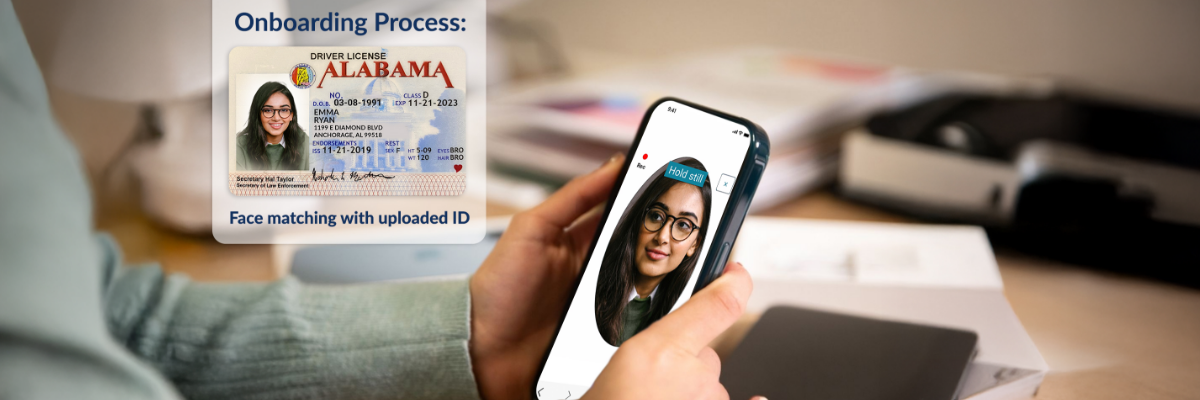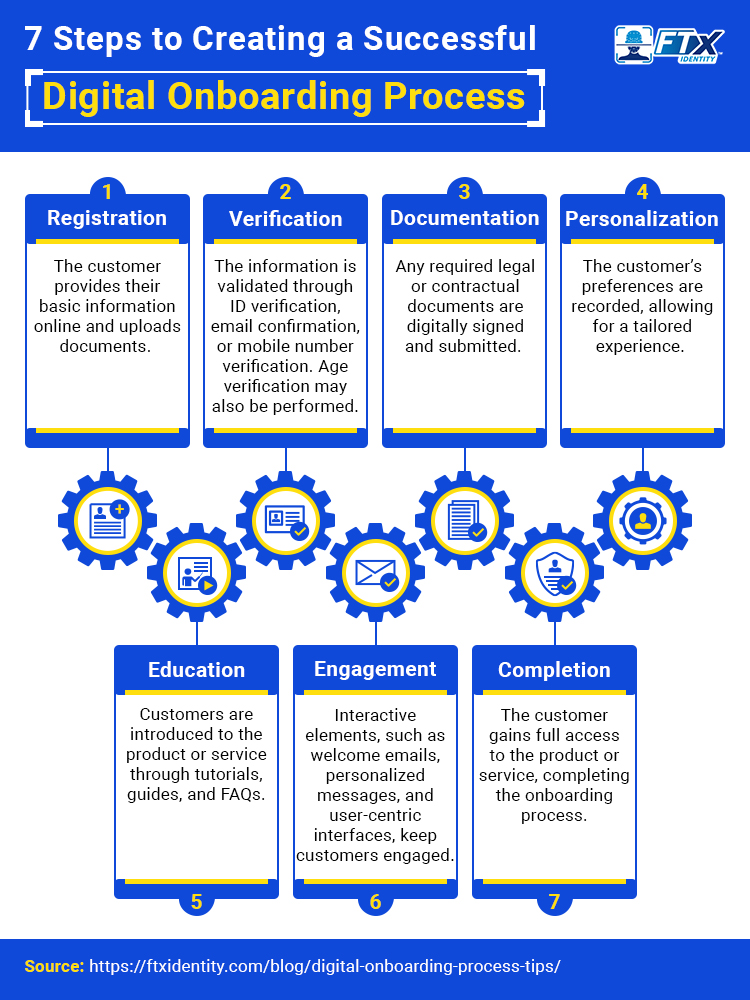A user-friendly digital onboarding process is key to success online.
Whether you’re running an ecommerce shop or you’re launching a banking app (with specific KYC requirements), the way you enroll customers can make or break progress. A streamlined process, for example, will get people enrolled and engaged faster, while a complicated process may crater app engagement rates.
What goes into a successful digital onboarding experience? We’ve highlighted some key design tips for digital onboarding processes that will ensure a seamless customer journey (along with suggestions for processes that include KYC and identity verification ).
Digitizing onboarding leads to tangible gains. FOCAL reports that companies investing in this transformation have seen a
- 28% reduction in cost
- 31% increase in activation speed
- 19% higher completion rates
What is Digital Onboarding?

Digital customer onboarding is the process of enrolling a customer online. This could include:
- Signing up for an app
- Registering for a new website
- Making a purchase online
- Authenticating a user in a banking app
The process includes various steps – from the initial customer visit to using your app or website as a verified user. And special care needs to be taken to design a process that’s user-friendly. If you fail at one step, your entire process might not work, and your app or website will bleed users.
Types of Onboarding
The spectrum of digital onboarding is broad, with each method designed to balance speed, security, and user experience. Understanding these nuances is key for any entity looking to refine its digital onboarding solutions.
1. Automated Digital Onboarding Process
Leveraging AI and advanced biometric analysis, this method offers real-time identity verification, making it the fastest and most scalable option. It’s particularly effective for digital banking and other financial institutions handling high volumes of new accounts, significantly reducing manual effort and potential human error while enhancing the digital customer onboarding solution.
2. Assisted Digital Onboarding Process
Sometimes, a touch of human connection elevates the digital experience. The assisted digital onboarding process is a hybrid, blending automation with real-time human interaction. Here, KYC agents guide new customers through the onboarding journey via secure video calls, verifying IDs and performing liveness checks. This approach is often adopted by financial institutions for higher-risk clients or when regulatory frameworks demand human oversight, offering a potent blend of digital convenience and human assurance.
3. NFC-Based Digital Onboarding Process
For unparalleled security and speed in identity verification for digital onboarding, NFC-based processes stand out. This cutting-edge method uses Near-Field Communication to directly read encrypted data from biometric documents like e-passports and ID cards. A simple tap of an NFC-enabled device against the document provides instant, highly accurate, and fraud-resistant verification. It’s an indispensable tool for regulated sectors where trust and robust data security are non-negotiable, significantly bolstering digital onboarding and ID verification.
4. Manual Digital Onboarding Process
While “manual” might sound counterintuitive in a digital context, the manual digital onboarding process still plays a vital role. This method involves asynchronous workflows where customers upload documents online, which are then reviewed by a KYC specialist at a later stage. Often deployed for more complex scenarios, such as corporate account setups or when extensive due diligence is required, it offers granular control over edge cases, ensuring a thorough yet accessible digital journey.
Digital Onboarding Process: Overview

The onboarding process should be designed to make the user’s journey from registration to full engagement as smooth as possible. A user-friendly process typically includes these steps:
- Registration: The customer provides their basic information online, initiating the onboarding process.
- Verification: The provided information is validated through various means, such as ID verification, email confirmation, or mobile number verification. This may include online age verification for some websites.
- Documentation: Any required legal or contractual documents are digitally signed and submitted.
- Personalization: The customer’s preferences are recorded, allowing for a tailored experience.
- Education: Customers are introduced to the product or service through tutorials, guides, and FAQs.
- Engagement: Interactive elements, such as welcome emails, personalized messages, and user-centric interfaces, keep customers engaged.
- Activation: The customer gains full access to the product or service, completing the onboarding process.
Infographic: 7 Steps to Creating a Successful Digital Onboarding Process

Understand the most common ways people bypass online verifications to better protect your process
How to Digitize Onboarding: Advantages and Challenges
Creating an effective onboarding system offers numerous advantages. However, it’s not easy. Here’s a look at some of the key advantages and challenges:
Advantages
1. Enhanced Efficiency
Digital onboarding streamlines the process, reducing the time it takes to onboard customers.
Automation of tasks, such as document verification and data entry, minimizes manual effort and human error.
Faster onboarding means customers can start using products or services sooner, increasing overall satisfaction.
2. Reduced Operational Costs
Digital processes eliminate the need for physical paperwork, reducing paper and printing costs.
Fewer manual interventions result in lower labor costs.
The efficiency gained often leads to cost savings in the long run.
3. Increased Customer Convenience
Customers can complete the onboarding process from the comfort of their own homes, eliminating the need for in-person visits.
The ability to onboard digitally at any time suits the busy lifestyles of modern consumers.
It offers a more convenient and accessible experience, enhancing customer satisfaction.
4. A Wider Reach
With digital onboarding, businesses can interact with customers no matter where they are, without being limited by distance or location.
It facilitates global expansion by eliminating the need for a physical presence in new markets.
The broader reach can result in a larger customer base and increased revenue potential.

Challenges
1. Data Security
Storing and transmitting sensitive customer information raises concerns about data breaches and cyberattacks.
Organizations must invest in robust cybersecurity measures to protect customer data and maintain trust.
2. Privacy Concerns
Digital onboarding involves collecting personal information, which can lead to privacy concerns.
Complying with data protection regulations, such as GDPR or CCPA, is essential to ensure customer privacy is respected.
3. Varying Digital Literacy Levels
Not all customers have the same level of digital proficiency, making it crucial to design onboarding processes that are user-friendly for everyone.
Providing clear instructions, user assistance, and user testing can help bridge the digital literacy gap.
Designing a Seamless Online Onboarding Process
Creating a successful digital onboarding experience requires thoughtful design and strategic implementation.
Here are 7 design tips to ensure your customers have a smooth journey:
1. User-Friendly Interfaces: Develop intuitive interfaces that guide customers through each step, minimizing confusion.
2. Clear Instructions: Provide concise and easily understandable instructions at every stage.
3. Progress Indicators: Display clear progress indicators to keep customers informed about their journey’s status.
4. Visual Consistency: Maintain visual consistency in branding and design elements to establish trust and recognition.
5. Mobile Optimization: Ensure the onboarding process is seamless across devices, catering to the mobile-first audience.
6. Assistance Features: Integrate live chat, chatbots, or help sections to assist customers in real-time.
7. Personalized Touches: Tailor the experience based on user data, making customers feel valued and understood.
Digital Onboarding in Banking

The banking sector stands at the vanguard of digital transformation, with digital onboarding KYC becoming a cornerstone of modern financial services. This shift isn’t merely about adopting new technology; it’s a fundamental reimagining of how banks engage with their customers from day one. It’s about delivering an exceptional digital onboarding experience that sets the tone for the entire customer lifecycle.
Traditional vs. Digital Onboarding in Banking
The contrast between traditional and digital onboarding in banking is stark, underscoring a paradigm shift in customer acquisition and service delivery.
| Factor | Traditional Onboarding | Digital Onboarding |
|---|---|---|
| Accessibility | Primarily in-branch or paper-based, demanding physical presence. | 24/7 online availability, accessible from anywhere with internet connectivity. |
| Convenience | Time-intensive, involving paperwork and manual steps; multiple branch visits are often required. | Rapid and convenient, enabling remote completion in minutes. |
| Documentation | Requires physical documents, photocopies, and wet signatures. | Accepts digital documents, scans, and e-signatures, minimizing paperwork. |
| Identity verification | Heavily reliant on in-person verification, leading to delays. | Employs digital identity verification methods like biometrics and document scanning for real-time validation. |
| Customer experience | Can be cumbersome and frustrating due to paperwork and waiting periods. | Delivers a smoother, more intuitive, and satisfying experience, boosting customer satisfaction. |
| Compliance and security | Compliance checks are often manual and prone to errors. Physical documents pose security risks. | Integrates automated compliance checks and encryption, bolstering security and mitigating fraud risks. |
| Cost Efficiency | Higher operational expenses due to paperwork, physical infrastructure, and staff. | Generally lower operational costs due to automation, reduced paperwork, and fewer in-person interactions. |
Digital Customer Onboarding for KYC and Identity Verification: Considerations
Designing a digital customer onboarding process for KYC (Know Your Customer) and identity verification requires special attention. KYC processes are crucial in industries like banking and fintech, where regulatory compliance and security are paramount. Here are some additional steps and considerations:
1. Transparent KYC Procedures
- Clear Explanations: Provide concise, plain-language explanations of the KYC requirements, emphasizing the importance of security and compliance.
- Checklist Guidance: Offer customers a checklist of required documents and information for KYC. This helps them prepare and reduces frustration.
2. Secure Identity Verification
- Biometric Authentication: Implement secure biometric authentication methods such as fingerprint or facial recognition for identity verification.
- Data Encryption: Ensure that all customer data and documents are encrypted both in transit and in storage to protect sensitive information.
- Trust-Building: Communicate your security measures to build trust.
3. User-Controlled Data Sharing
- Data Consent: Allow customers to control what personal information they share during KYC. Provide clear options for consent and data management.
- Transparency: Clearly articulate how customer data will be used, stored, and protected, reassuring customers about their privacy.
4. Efficient Review Process
- Streamlined Review: Design an efficient KYC review process to minimize delays and wait times for customers.
- Automation: Implement automation and data validation techniques to expedite the verification process.
- Progress Updates: Keep customers informed about the progress of their KYC review to manage expectations.

5. Accessible Support
- Live Assistance: Offer real-time support through live chat or dedicated customer service representatives who can guide customers through the KYC process.
- Help Center: Create a comprehensive help center with KYC FAQs, troubleshooting guides, and contact information for assistance.
- Accessible Channels: Ensure that customers can easily reach out for help and support through various channels, including email, phone, and chat.
6. Feedback Mechanisms:
- Customer Feedback: Solicit feedback from customers regarding their KYC experience. Use surveys or feedback forms to gather insights.
- Continuous Improvement: Act on the feedback received to make ongoing improvements to the KYC process, demonstrating a commitment to customer satisfaction and efficiency.
7. Visual Progress Tracking:
- Visual Timeline: Provide customers with a visual timeline or progress tracker that illustrates where they are in the KYC process.
- Completion Status: Clearly mark completed stages and indicate the steps remaining. This visual cue gives customers a sense of control and helps them anticipate what’s ahead.
- Estimated Time: Include estimated time indications for each step to manage customer expectations regarding the time required for completion.
Ultimately, your onboarding process should be personalized to customers to build trust and maximize engagement.
Risk Mitigation Strategies in Digital Customer Onboarding
While the digital realm offers unparalleled opportunities, it also introduces new vulnerabilities. Effective digital customer onboarding necessitates robust risk mitigation strategies to safeguard both institutions and their clients.
1. Implementing Multi-Factor Authentication (MFA)
Beyond a simple password, MFA adds crucial layers of security. Requiring additional verification steps – like a code sent to a mobile device or a biometric scan – significantly complicates unauthorized access, fortifying the onboarding pipeline.
2. Real-Time Fraud Detection
The sophisticated nature of modern financial fraud, including synthetic identity fraud, demands equally sophisticated defenses. AI-powered tools capable of real-time fraud detection are indispensable, allowing banks to instantly identify and prevent illicit activities as they unfold.
3. Tokenization and Data Masking
Protecting sensitive customer data is paramount. Tokenization and data masking convert confidential information into a secure, unintelligible format before processing or storage. This proactive measure drastically reduces the risk of exposure in the event of a data breach.
4. Zero-Knowledge Encryption
A truly innovative approach, zero-knowledge encryption enables the verification of a customer’s identity without ever storing their sensitive information. This technique provides an unparalleled layer of security, fostering customer trust without compromising privacy.
5. Continuous Security Training
Technology is only part of the equation; human vigilance is vital. Regular, comprehensive security training for employees on best practices and emerging threats creates a robust first line of defense against insider threats and social engineering, minimizing human error as a vector for data exposure.
How FTx Identity Powers Digital Onboarding
FTx Identity makes customer onboarding faster, easier, and more secure. Designed with compliance in mind, it helps businesses meet KYC and Anti-Money Laundering (AML) requirements while delivering a smooth experience for users.
With built-in tools for document verification and data checks, FTx Identity takes the guesswork out of identity verification. It integrates easily into your existing systems, so you can start verifying customers right away – without slowing things down.
Whether you’re focused on reducing fraud, cutting manual steps, or improving trust at sign-up, FTx Identity gives you the tools to do it all with confidence.
Ready to get started with FTx Identity? Contact us today to arrange a consultation and enjoy a demo!
Is Your Onboarding Process Costing You Conversions?
Your digital onboarding process shouldn’t slow you down—or your customers. Create onboarding experiences that drive conversions, reduce fraud, and keep you compliant with built-in KYC and AML tools.
